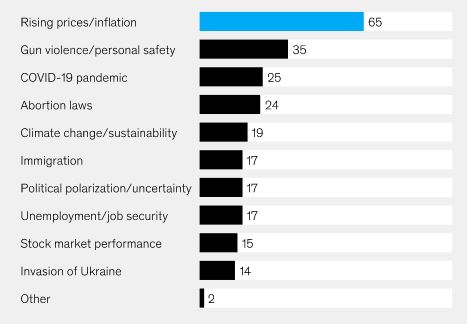
Retaining your best and brightest employees can be difficult, even in the best of times.
But when inflation is through the roof, eroding the value of every dollar, employee retention gets even tougher.
This is nothing new, though, as the relationship between inflation and people quitting their jobs has been well-known for years.
According to an article from the Federal Reserve Bank of Chicago, research has shown that there’s a strong positive relationship between the quit rate and the inflation rate. This means that when inflation goes up, the number of people quitting their jobs tends to go up, too.
At any rate, employers should expect this sort of thing, as people have to do what’s necessary to make ends meet, but it’s important to point out that there is a well-established relationship between these two metrics.
And with inflation at a 40-year high, this issue doesn’t seem like it’s going anywhere anytime soon.
According to a report from WorldData.info, as of September 2022, the inflation rate was sitting at 8.2 percent, which is more than double the average inflation rate between 1960 and 2021.

Obviously, this is concerning for everyone, not least employers, and even consumers haven’t hesitated to express that this is their foremost concern.
A survey of U.S. consumers from McKinsey & Company conducted in July 2022 found that inflation was their number one concern, with nearly two-thirds of respondents saying this is the issue they’re most worried about.

In any case, when inflation is this high, and you can’t afford to pay your employees more, retaining your top talent can seem downright impossible.
But luckily, there’s a lot more you can do to improve employee retention other than just raising salaries.
So, if you’re concerned about retaining employees, and you’re wondering what you can do about it, then you should definitely keep reading.
Because in this article, I’m going to explain what you can do to improve employee retention in the face of inflation, and explore some of the tactics I’ve used to help my clients retain more of their employees.
How You Can Improve Employee Retention in the Face of Record Inflation
Given everything that’s gone on over the last few years, the world of business can look pretty bleak.
But as a business owner, you’re always going to be dealing with challenges, so it’s best to try to stay positive and roll with the punches. That’s what entrepreneurs do, right?
That being said, for those of you who are concerned about the effect inflation is having on employee retention, below I’ve provided several potential solutions, so you can reduce employee turnover and continue to retain more of your best, in spite of inflation.
Pay Them More Money

I know I said I’d offer solutions to those of you who can’t afford to do this, and I’ll get into that a bit more in a minute.
But I’m not going to sugarcoat things.
The fact of the matter is, in this economic climate, one of the best things you can do to improve employee retention is to pay your employees more.
I know it sounds simplistic, but people are resigning in droves, job vacancies are through the roof, and as a result, companies are competing for talent like never before.
So, if you can afford to do so, I would recommend paying your employees more money than the job market might call for, but you shouldn’t just be throwing pay raises around willy-nilly. You have to be strategic about it.
You’ve got to sit down and analyze each and every position to determine whom you can and can’t afford to lose, and then try to balance the cost of potentially losing an employee versus the cost of paying them more.
And remember, there are many different ways to offer higher compensation to your employees, beyond just giving them a salary increase.
Some alternatives include giving them a one-time lump sum, or implementing a bonus structure based on key performance indicators (KPI) where the employee is rewarded for the company’s success, as well as their own contribution.
But keep in mind that regardless of whether you pay someone more, or hire someone to replace them, it’s going to cost you.
And in many circumstances, it can actually cost more to hire and train a new employee than to give one of your current employees a raise.
You see, whenever you hire someone, you’re signing yourself up for a lot of risks.
You don’t know what it’s going to cost to hire a replacement, you don’t know what this person is really like, and whether or not your staff will be able to pick up the slack could be anyone’s guess.
So, before you pull the trigger on anything, make sure to take all these things into consideration.
Give Them Flexibility
The dust from the pandemic may have finally settled, but employees are still not ready to give up the perks they took for granted during the pandemic.
With that said, one of the main concerns for employees today is the ability to work remotely, or have some sort of a hybrid work schedule.
Unfortunately, in some circumstances, this just isn’t possible.
For instance, if you own a warehouse, obviously the employees in your shipping and receiving department can’t load or unload trailers from home.
But if you can make this work, you definitely should.
Because despite the fact that the lockdowns are over, and life has more or less returned to normal, a lot of workers are still scared to be around other people.
At the same time, many people have simply gotten a taste of what it’s like to work from home, and avoid spending the time and money it takes to commute, and they do not want to go back to the way things were.
So, if there’s any way for you to implement some sort of remote or hybrid work options for your employees, don’t think twice about doing it.
Many people today will not hesitate to quit their job if they can find an employer who allows them to work from home, or have some sort of flexible work schedule.
So, instead of giving your competitors an advantage, and making it easier for them to poach your employees, if at all possible, you should try to give your employees this flexibility.
One option I like to recommend is allowing your employees to work 10 hours per day, four days per week, so they have an extra day off, and they only have to pay the high price of commuting on four days of the week instead of five.
Another option would be to give them one or two days per week when they can work from home.
Whatever you choose to do, if you’re giving them this flexibility, it shows that you care, and it’s putting you at a competitive advantage, as you’re providing one of the perks that today’s workers desperately want.
Let Them Know You Care

Paying employees more, or allowing them to work from home, are both great ways to show them that you care, but this stuff isn’t always possible, and there are many other ways to go about doing this.
First and foremost, this requires building relationships with your employees.
This means you have to take the time to have conversations with your staff, and ensure they know you consider them important members of the team.
So, stop hiding in your office, get out on the shop floor, and start talking to your employees – find out more about them, what they enjoy, what struggles they’re dealing with, and ask them for feedback.
Believe it or not, this sort of thing goes a long way, because when people know they’re valued by their employer, they’re going to be much less likely to quit, even if you can’t give them everything they want.
Working for some giant corporation might pay more, but the rigidity and bureaucratic nature of these kinds of organizations tend to turn people off.
And in addition to trying to get to know your employees better, you should do whatever you can to try to be open and honest about things.
For example, if people are asking for more money, but that’s not possible, be frank with them. Tell them straight up that the company can’t afford it, but then follow that statement by asking them what else you can do instead.
One of the things I like to teach clients to do, in terms of showing employees that they care, is what I call talent management. This involves reviewing all of your employees, making sure they have room to grow in their careers wherever possible, and even asking them what they’d like to do in their current role or in other positions. This starts with the CEO and then flows down to every level within the company.
In any case, your employees may prefer to move to a different department, or maybe they’d like to take on more responsibility, but you’ll never know if you don’t ask them.
This may seem trivial, but when the person who signs an employee’s checks is asking them what they want to do, it can have a huge impact, and this only provides more incentive for them to stay.